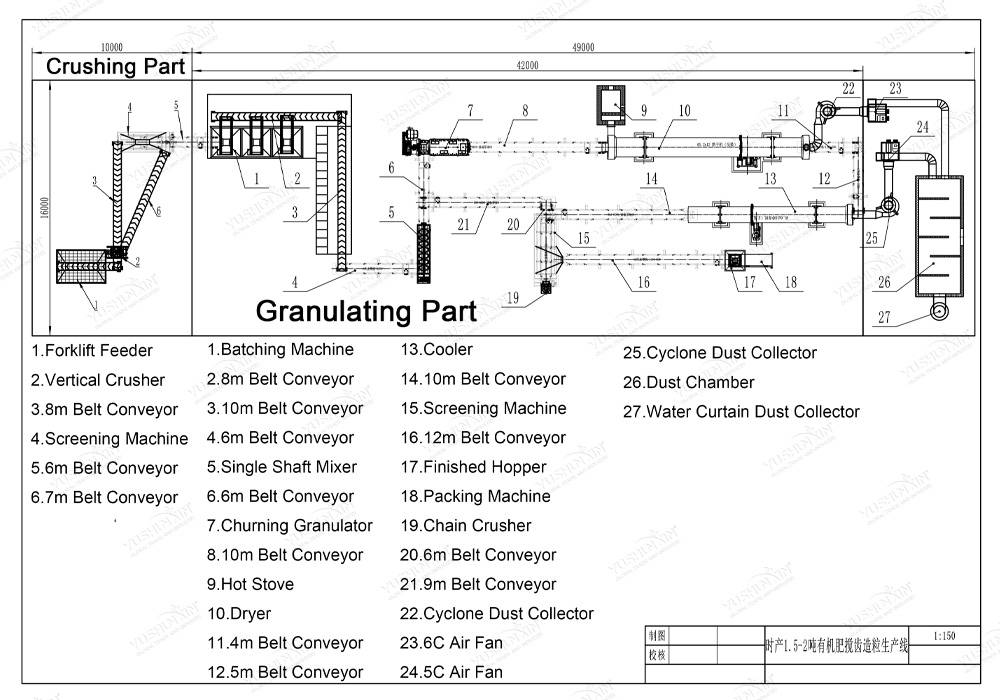

Systèmes de stockage et d'alimentation des matières premières:
Équipement de mélange:
Équipement de granulation (Si nécessaire):
Équipement de séchage:
Équipement de refroidissement:
Équipement de tamisage et de dépistage:
Équipement de revêtement (Facultatif):
Équipement d'emballage:

Nutriments primaires:
Nutriments secondaires:
Micronutriments (Orientés):
Agents chélateurs (pour les micronutriments):
Acidulants ou experts en pH:
Additifs:
Matériaux de transport (facultatif):
Le coût de chaque chaîne de production varie en fonction de la capacité de production, degré d'automatisation, et des besoins spécifiques. Remplissez le formulaire ci-dessous et nous vous fournirons un devis précis!
Si vous êtes intéressé par notre équipement de fabrication d'engrais, Veuillez soumettre vos exigences et contacts, puis nous vous contacterons dans deux jours. Nous promettons que toutes vos informations ne seront pas divulguées à personne.
- L'entreprise a été fondée dans 2005 et s'est concentré sur la recherche et le développement et la fabrication d'équipements d'engrais biologiques depuis 20 années. Il a construit une base de production d'équipement d'engrais organiques à grande échelle de 40 000 m, Utilisation de granulation avancée, Technologies de séchage et de dépistage pour améliorer l'efficacité de la production et la qualité des produits.
- Une entreprise d'importation et d'exportation auto-opérées avec plus que 80 ingénieurs professionnels du monde entier, servir plus de 100 pays et régions du monde, 5,000+ cas de service à la clientèle, 10 centres de traitement, 3 machines à découper laser, et plus de 60 Équipement de différents types.
- Maintenir une coopération à long terme et étendue avec de nombreux instituts de recherche scientifique et universités, with a professional R&D team, Il peut optimiser continuellement les performances de l'équipement en fonction de la demande du marché.
- Matériaux à haute résistance à l'usure, Carbon Steel Q235 / alliage est sélectionné pour s'assurer que l'équipement est durable et réduire les coûts d'entretien.
- Adopter des systèmes de contrôle intelligents pour améliorer le niveau d'automatisation de la production et réduire la dépendance manuelle.
- ISO, CE, Certification internationale SGS
- Avec une capacité de production à grande échelle, il peut répondre à différentes exigences de capacité de production (petit, lignes de production moyennes et grandes).
- Une gamme complète de modèles d'équipement, Convient à la production de divers types d'engrais tels que les engrais organiques, engrais composé, engrais biologique, engrais soluble dans l'eau, engrais liquide, etc..
- La conception personnalisée peut être fournie en fonction des besoins des clients, y compris la capacité de production, disposition du site, Normes de protection de l'environnement, etc..
- Fournir un ensemble complet de solutions de ligne de production, y compris la sélection des équipements, installation et mise en service, formation technique, etc..

- Fourniture d'usine directe, Réduire le lien intermédiaire, Et le prix est plus compétitif.
- L'équipement a une efficacité énergétique élevée, réduit la consommation d'énergie, et aide les clients à réduire les coûts d'exploitation à long terme.
- Fourniture d'usine directe, Réduire le lien intermédiaire, Et le prix est plus compétitif.
- L'équipement a une efficacité énergétique élevée, réduit la consommation d'énergie, et aide les clients à réduire les coûts d'exploitation à long terme.
Fourniture d'une machine de polissage d'engrais à un important producteur d'engrais aux Pays-Bas
Livraison réussie de granulateurs à double rouleau 1 T/H à des clients en Turquie et au Royaume-Uni
Solution efficace de retournement du compost livrée à un client philippin
Livraison réussie d'un granulateur à disques à un client chilien pour la production d'engrais
Augmenter l'efficacité de la pelletisation pour GoodEarth Group, Afrique du Sud
Les clients équatoriens louent fortement la machine à assaisonnement des eaux usées
Éloge élevé du client du Vietnam pour la ligne de production d'engrais en potassium
La ligne d'engrais mexicaine a été installée avec succès
Notre équipement de production d'engrais a été livré avec succès en Australie sans aucun dommage.
Chargement de notre ligne de production en engrais organiques